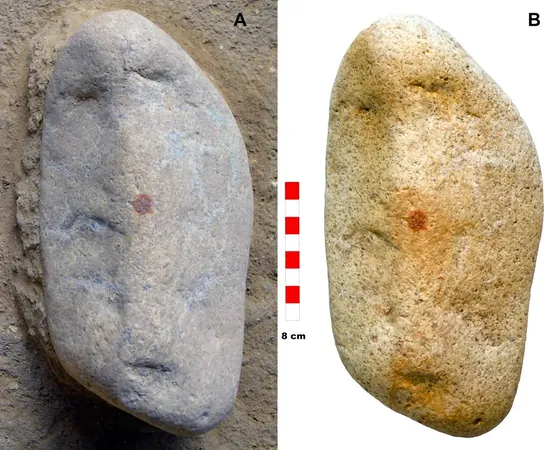
Groundbreaking Discovery: Neanderthals Might Have Created Artwork!
2025-06-02
Author: Ying
Historic Find in Spain!
In a stunning revelation, archaeologists in Spain have unearthed a pebble that could represent the earliest definitive proof of Neanderthal artistry. This intriguing rock, thought to be around 43,000 years old, bears what appears to be a human fingerprint made with red pigment, suggesting that our ancient cousins engaged in some form of artistic expression.
The Evidence of Intentionality
When the research team, led by Professor María de Andrés-Herrero from the Complutense University, first encountered the pebble, its unusual shape and the distinct reddish hue, particularly concentrated where a nose might be depicted, sparked curiosity. Was this a mere accident or a deliberate act of creativity?
Unraveling the Mystery of the Markings
Using cutting-edge imaging techniques, scientists identified intricate dermatoglyphics—patterns akin to those found in human fingerprints. It’s believed that an adult male Neanderthal dusted his finger against the stone's surface, intentionally leaving behind the red pigment.
A Leap in Understanding Neanderthal Creativity
These findings challenge the long-held belief that symbolic thinking and artistic expression were exclusive to modern humans. The Neanderthal community of that era not only painted cave walls but may have also carried personal artifacts with symbolic meanings. Previously regarded as purely functional, the use of ochre—an iron-oxide based paint—now hints that Neanderthals had a sense of creativity.
What This Means for Archaeology
Experts originally speculated that the red pigment might have resulted from routine activities involving colored minerals, but the positioning of the pigment suggests otherwise—it was placed purposefully. This pebble, discovered in a layer dating back to the late Mousterian period, was likely chosen for reasons beyond mundane utility.
A Unique Imprint
Once confirmed via digital imaging, forensic experts examined the ridge patterns of the fingerprint, providing insight into its maker. Although the imprint shares characteristics with male traits, a comprehensive comparison is hindered due to a lack of modern reference prints for Neanderthals.
The Significance of Symbolic Thought
This pebble is more than just a marked stone; it signifies a potential shift in our understanding of early human-like behavior. Many scientists now argue that Neanderthals were capable of nuanced symbolic thinking, indicated by their varied tool sets and the utilization of natural pigments for decoration and possibly communication.
Conclusion: Rethinking Neanderthal Culture
As discussions on what constitutes 'art' continue, this discovery stands out as evidence of personal agency and symbolic awareness in our prehistoric relatives. The implications of this finding could reshape how we view Neanderthal culture and creativity in the larger narrative of human evolution. The discovery was detailed in the journal Archaeological and Anthropological Sciences, inviting further exploration into the artistic capabilities of our ancient relatives.


 Brasil (PT)
Brasil (PT)
 Canada (EN)
Canada (EN)
 Chile (ES)
Chile (ES)
 Česko (CS)
Česko (CS)
 대한민국 (KO)
대한민국 (KO)
 España (ES)
España (ES)
 France (FR)
France (FR)
 Hong Kong (EN)
Hong Kong (EN)
 Italia (IT)
Italia (IT)
 日本 (JA)
日本 (JA)
 Magyarország (HU)
Magyarország (HU)
 Norge (NO)
Norge (NO)
 Polska (PL)
Polska (PL)
 Schweiz (DE)
Schweiz (DE)
 Singapore (EN)
Singapore (EN)
 Sverige (SV)
Sverige (SV)
 Suomi (FI)
Suomi (FI)
 Türkiye (TR)
Türkiye (TR)
 الإمارات العربية المتحدة (AR)
الإمارات العربية المتحدة (AR)